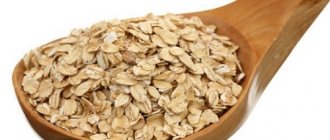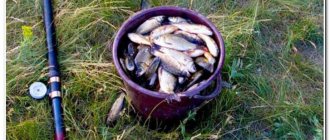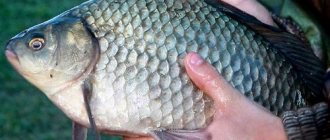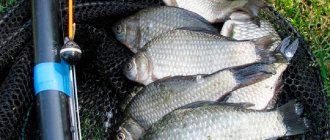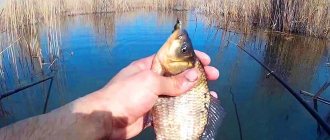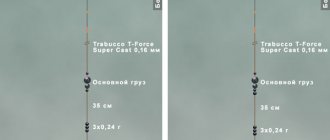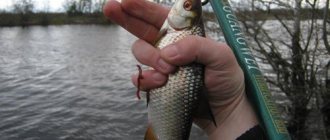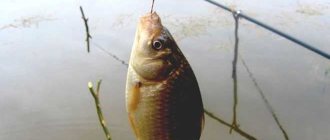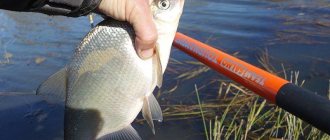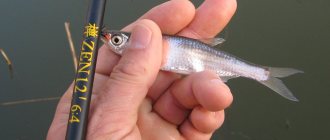Crucian carp is considered one of the most common fish and is found in literally all fresh water bodies. You can fish with it at any time of the year, because even during cold weather and severe ice freezing, crucian carp retains its vital functions. The most reliable and proven method of fishing is catching crucian carp with a float rod.
Rod selection
The rod is the most important and basic part, including in a float rod, so the further success of fishing depends on its choice. In this type of fishing rod, there are three types of fishing rods - fly rod, Bolognese rod and match rod. Among fishermen who catch crucian carp, a fly rod is considered popular, because its advantage is the accuracy of casting. Bolognese and match, in turn, provide the opportunity for fishing at long distances from the shore. Therefore, the choice of fishing rod directly depends on the designated fishing location.
Fly fishing rod
Very convenient for catching crucian carp. The best fly rod should have the following parameters:
- The optimal rod length is up to five meters. This footage makes it possible to catch larger crucian carp that live near the shore. The further away from it, the smaller the crucian carp is found.
- The presence of a reel on a fly fishing rod is not of great importance; it is more often used to transport fishing line; the most common one in the form of a drum is quite suitable.
- Usually, for fishing for crucian carp, a monofilament fishing line of two tenths of a millimeter is taken on a float. However, if you are fishing in an area where there is a lot of algae, you should take a thicker line. Particular attention should be paid to its length; it should be less than the length of the fishing rod itself.
The advantages of a fly fishing rod are: accurate casting, ease of use, ease of changing equipment, and a low chance of tangling the line.
Match tackle
Unlike a fly rod, it makes it possible to fish far from the shore at various depths.
Description:
- Lightness and compactness allow you to make long casts, up to seventy meters from the shore.
- The float must be bright so that it is clearly visible at long distances.
- Most often, a rod up to four meters long is used, but up to seven meters are also found. Includes guide rings and reel.
- The best reel for catching crucian carp is a spinning reel with a friction brake. Allows the use of lightweight equipment.
- The fishing line is monofilament, small in diameter, about two tenths of a millimeter. Since a fly rod is used for fishing at depth, the fishing line must be elastic, memoryless, and larger than the length of the rod.
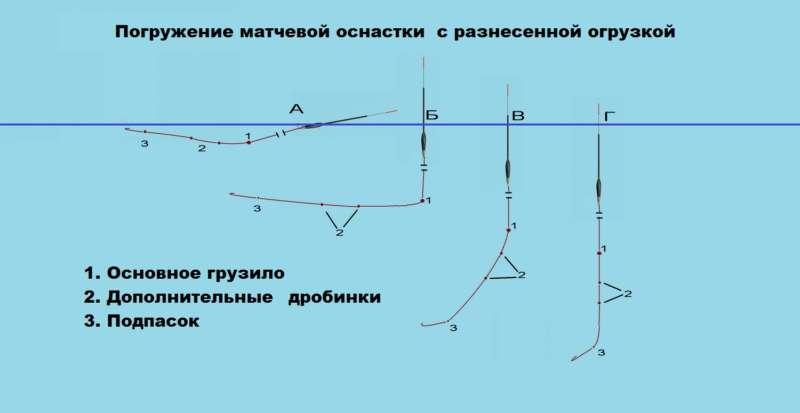
Proper rigging of a float rod
The float rod is universal; it can be used for fishing in different bodies of water for many types of fish. It happens that one fisherman gets a good catch, while another is content with, at best, small fish. It's all about what equipment the fisherman chooses to catch crucian carp on a float. If you collect a thick fishing line and a huge hook, then of course there will be no sense in such fishing, so the main thing is to choose all the components correctly. Let's take a closer look at them.
Hook selection
The success of fishing directly depends on the hook you install. If we talk about catching crucian carp, then you need to know a few subtleties that can help you make your choice:
- The eye of the hook should be a straight ring.
- The forend is standard, with a sting bent inward, so that the crucian carp will not feel it when biting.
- Preferably black. Crucian carp more often falls on such hooks.
- The hook must be well sharpened.
- You also need to remember about the bait, it also affects the choice of hook. For example, for massive bait and catching large specimens of crucian carp, a large hook is needed.
Depending on the size of the crucian carp found in your pond and the hook you purchase, if the fish is small, then number five (by Russian standards) is taken; if large, then number seven is suitable.
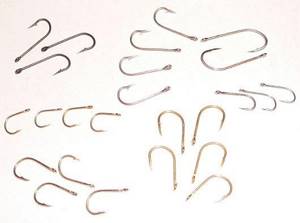
Coil selection
Inertial and inertialess reels are suitable for a float fishing rod.
Inertia coils
- The drum is the simplest reel, suitable for fishing in weak currents. It is light in weight and designed for catching small or medium fish. It can be equipped with a fly fishing rod.
- A wire reel is more complex; in its mechanism, the spool rotates on bearings. It is good to use in the current: the bait is thrown, the line is unwound by the current, and the fisherman slowly reels it back.
Spinning reels
You can fish long distances from the shoreline or by boat. In this case, the fishing line is thrown off the stationary spool. It is convenient to equip match fishing rods with a spinning reel.
When fishing for crucian carp with a float, we recommend using a spinning reel.
Float selection
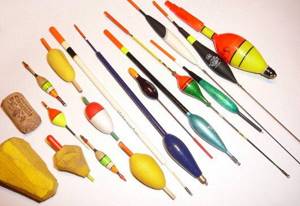
Let's consider three important parameters that determine the choice of float for fishing for crucian carp:
Color
The color scheme does not affect the progress of fishing in any way. For your convenience, you can choose the color that will allow the float to be more noticeable. Most often it is red.
Size
Small floats, the mass of which does not exceed five grams, work well in calm water with low current and shallow depth. It is preferable to catch crucian carp close to the coastal zone, no more than ten meters. Just such floats are ideal for a fly fishing rod. Otherwise, when fishing takes place far from the shore, at great depths with strong currents and gusts of wind, large floats are chosen.
Sensitivity
To catch crucian carp you need a very sensitive float, this factor depends on its tip. It should be as thin as possible. The elongated shape and low load capacity also have a positive effect on the sensitivity of the float.
Let's present the rating of the best store floats according to our version:
All floats shown below are Balsax products. They have the most sensitive floats when fishing for crucian carp.
- 1 place. Maggio – with one attachment point, can be used in sliding rigs. It has a retracted shape and a thin top.
- 2nd place. Perla is teardrop-shaped with a keel and an elongated antenna. Good for use in calm water.
- 3rd place. Siena – long keel, suitable for medium flow waters. The top is a little thick.
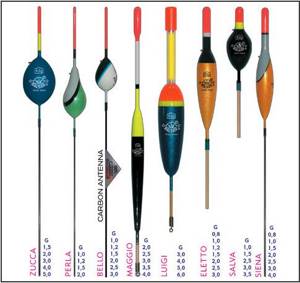
You can make a float yourself, and it’s no worse than those sold in stores. True, only professional fishermen can do this correctly. The advantages of many homemade products are that they are easy to perfectly adjust to all the parameters of your fishing rod and set the desired size and properties of the float yourself. It is made from polystyrene foam, wine corks, and straws.
Goose feather float
The goose feather fishing float is somewhat popular due to its great sensitivity, and it is also free. Making it is not at all difficult.
- You need to find a fresh feather;
- Pluck it, that is, remove all the plumage;
- Dry;
- Use a bright marker (red, orange) to color the upper part of the future float;
- Wrap 1 layer of black tape around the upper, bright part of the float, or paint it with a black marker (this will be our guideline limiter);
- Place a bead on the glue below into which the fishing line will be threaded;
- To prevent the marker from being erased when fishing for crucian carp, you should wrap the float with one layer of tape.
Instead of tape, you can use a thin layer of glue or varnish. The main thing is not to overdo it. In order for the feather to stay afloat and not sink, it must have as much hollow space as possible. For this you need a feather from a large goose.
Loading the float
For a normal shipment, 2-3 medium weight lead pellets are enough. But if you want to make the float as sensitive as possible, you should load it using 3-5 lead pellets or 2-3 heavier weights, as experts advise. This will allow the float to almost completely disappear under a layer of water, leaving only a small part of it on the surface. When biting there will be a very noticeable nod of the top of the float, you will feel it immediately.
You can decide for yourself how many pellets you need to load the float, as it will depend on the type of float you have. This is not at all difficult, taking into account the fact that on many modern floats its weight is written, and how much the load on a given float should weigh. The equipment below can be safely called a donka.
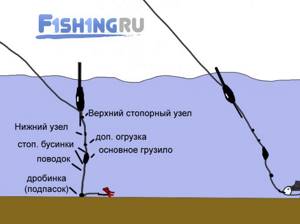
Line selection
When fishing for crucian carp with a float, it is best to use a monofilament fishing line of small diameter. Its choice directly depends on the size of the crucian carp being caught. In this case, there are several options:
- Crucian carp up to one hundred grams - select a fishing line of 0.1 mm, a leash in this case of 0.07 mm.
- Crucian carp from two hundred grams - the diameter of the fishing line is 0.12 mm, and the leader is 0.09 mm.
- Crucian carp is about a kilogram - a line of 0.14 mm, if there is a strong current, it is better to take 0.16 mm, a leash of 0.1 mm.
If the mass of crucian carp in a given reservoir is not known to you, then it is better to play it safe and prepare several fishing lines with different diameters. A high-quality fishing line must have the following qualities: be elastic, memoryless, hardly noticeable, durable, uniform.
Among the many manufacturers, fishermen most often prefer the following companies: Maver, Colmic, Milo, Mikado.
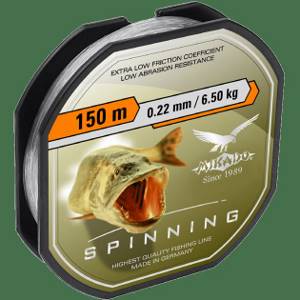
Mikado. Made: Germany Milo. Manufacturer: Japan
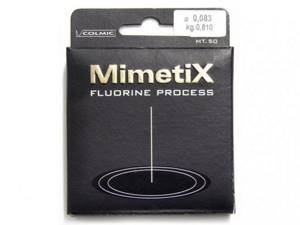
Colmic. Manufacturer: Japan
Slipknot
When fishing with a match fishing rod, the tackle is cast far from the shore, and the fisherman must adjust the casting range and accuracy. This is what a sliding float is used for. Its main advantage is that the float is installed on the equipment in a movable position. The fisherman himself decides in what range he will move, limiting the movement with a stopper.
Sliding knot diagram:
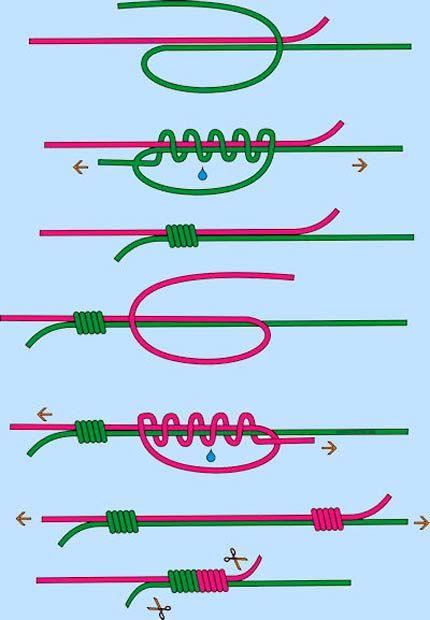
Some people use special devices (beads made of silicone or rubber) as a stopper, but the sliding knot is especially popular. It is quite simple to manufacture; the materials can be different - silicone, fishing line, thread. Unfortunately, the fishing line knot is hard to see and can move. Therefore, it is most practical to knit from a backing cord or regular woolen thread.
However, if the angler is a beginner, such a knot can be purchased at the store. It is sold on a tube, you just need to remove it and fix it on your fishing line.
Professionals can make a stopper right at the fishing spot from improvised materials. In this case, you should follow a couple of simple rules:
- The size of the knot depends on the diameter of the rings on the mast fishing rod; it should not get stuck when casting.
- The ends may stick out a little, so don't cut them off completely. If the knot is loose, it can be easily tightened.
Using tackle with two hooks
Professional fishermen are increasingly resorting to the method of using two hooks on one tackle. It helps you figure out which bait will work and increases the chances of a successful bite.
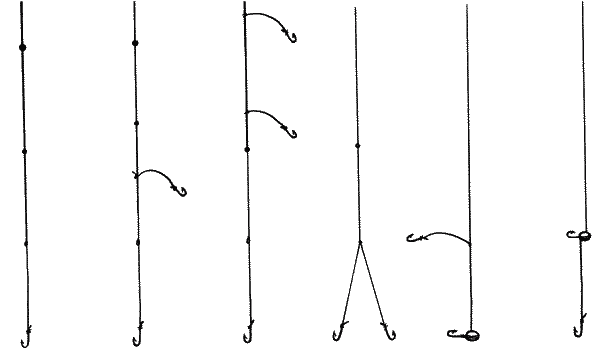
For a float fishing rod, there are four options for mounting paired hooks:
One leash is higher than the other:
- In a short time you can determine which bait is more in demand.
- Less chance of tangling the tackle when hooking.
Leashes at one level:
- Two hooks are placed in the bait at once.
- Very often the leashes are intertwined with each other.
The leads come after the sinker:
A fairly common tuning method, it is popular among fishermen.
- Provides high sensitivity.
- The large distance between the leashes prevents them from getting tangled.
- This design is not convenient to use in places with a lot of bite.
The leads go to the sinker:
- Ensures accurate casting even over long distances.
- Leashes can get tangled.
I would like to note that the use of two hooks makes the tackle weaker and the bite less noticeable. Therefore, the fisherman should be as careful and attentive as possible.
Crucian carp killer tackle
We couldn’t help but mention the “crucian carp killer” tackle, as it is very popular, even despite its unsportsmanlike nature. It is also used when fishing for crucian carp on a float. This tackle is a self-cutting (this is its trick) structure, consisting of: 1-3 spring feeders, 2-3 hooks, a swivel with a clasp, a sinker and stop beads.
Since the “crucian carp killer” tackle deserves special attention, we separately analyzed it extensively in another article, and described how to make it with your own hands. This tackle is very catchy, but we remind you that this tackle is not sporting. There is a similar gear for carp fishing, it is called “Carp Killer”. But about it in another article.
Mormyshka
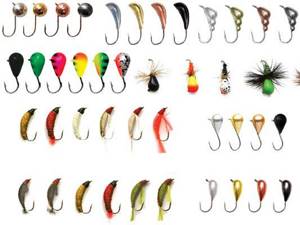
Fishermen also often use a jig when catching crucian carp with a float. A jig is a hook surrounded by a shot, the outer part of which is covered with a shiny spray, which, in turn, attracts crucian carp.
It is worth using a jig for crucian carp weighing up to 5 grams. In reservoirs where small and medium-sized crucian carp are found, the weight of the jig should not exceed 1-3 grams. In terms of color, you should give preference to either black or bright orange and gold colors.
Types of jigs:
- Disk;
- Pellet;
- Drop;
- Ant;
- Oatmeal.
There is no universal answer to what type of jig to catch. But in your stock it is necessary to have as many types of jigs as possible, so that in the absence of a bite you can easily change to another.
Watch the process of equipping a float rod for crucian carp online:
Baits and baits
It is known that the taste preferences of crucian carp vary depending on many factors. Very often they are influenced by weather factors and habitat features (water temperature, depth, vegetation). Baits can be of both plant and animal origin; artificial baits have also recently appeared, but they have not yet achieved sufficient popularity.
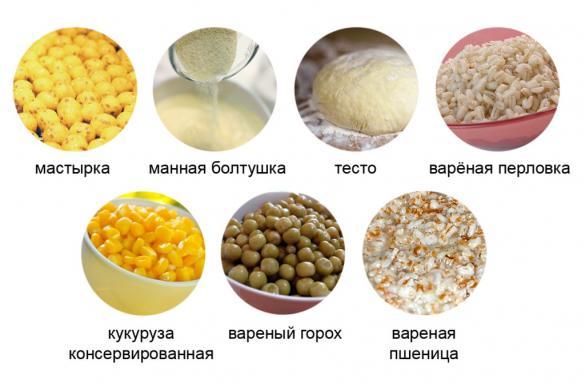
Plant attachment
It works well in the summer, when the reservoir has already warmed up well. Most often these are cereals (barley, wheat, semolina, rolled oats) and there may also be dough in different preparations.
- Pearl barley is cooked in water and then placed on a hook. The pearl barley must not be overcooked, otherwise it will fall apart.
- Wheat – filled with water and stored for two weeks. Then it easily stays on the hook and lures the crucian carp with its sour smell.
- Semolina is filled with water, then placed in cheesecloth and immersed in boiling water until cooked. Open the gauze and divide into pieces.
- Mix Hercules
- Dough - there are many recipes for its preparation; you can add various additives to the flour (semolina, eggs, even honey and cottage cheese). The main thing is that the water used is from the specific reservoir where fishing is carried out, and not flowing from a tap.
All these nozzles can be rubbed and soaked in garlic, as advised by the presenter of the “Floating Workshop” Evgeniy Sereda.
Animal attachment
Crucian carp bite with pleasure on animal bait in the cold season, before the water warms up.
His favorite delicacies are worms, maggots and bloodworms. Worms:
- Dung worms, red in color, are suitable.
- Quite visible in the aquatic environment.
- Firmly fixed on the hook.
- They move actively, thereby attracting the attention of fish.
Maggots:
- Often gets off the hook.
- In addition to crucian carp, other small fish also love it.
Bloodworm:
- Mosquito larva, good bait for crucian carp.
- Doesn't stay on the hook well enough.
You can also combine attachments (see picture). Use, for example, worms and pearl barley.
Bait
Almost any bait is suitable for catching crucian carp with a float rod. Crucian carp is a very voracious fish. We will divide all baits into animal and vegetable.
If you want to find out in more detail what they use to catch crucian carp, you can read our article.
Animal baits include:
- Worm.
- Maggot.
- Bloodworm.
Vegetable:
- Black and white bread.
- Pearl barley.
- Boiled peas.
- Corn.
- Potato.
- Dough.
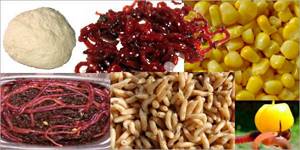
You need to choose bait based on fishing conditions and time of year. So, in summer you should give preference to plant baits, in winter – to more nutritious animals.
- Bait for fishing in closed reservoirs (no current). When there is no current in the reservoir, the bait will last longer. All of the above baits can be used. In such reservoirs the effectiveness of bait increases significantly. You can also get by with less bait. It is better to sprinkle it in small portions to allow the bait to do its job.
- Bait for fishing in open waters (there is a current). In strong currents, the bait that is on the hook must be firmly set. More often, in a strong current, the equipment is carried away, the bait gets caught and falls off. A strong current can knock down the following baits: bread, potatoes, dough. Therefore, they are used least often in reservoirs with strong currents.
The best options for feeding crucian carp
Complementary food is needed to lure crucian carp to the designated fishing spot. This is done immediately before fishing. No matter what kind of bait, it should be in powder form. The advantage is that this consistency is easy to spread throughout the pond. Usually bait is prepared from several ingredients, but it is very important that it is less tasty than the bait itself. Let's list a few of the best baits for crucian carp:
- Cake soaked in vegetable oil.
- Hemp grains, boiled over low heat.
- Ground cereals.
- Sweet flavors.
- Ground dill and anise seeds and garlic.
- Favorite delicacy: crumbled honey gingerbread.
We have a detailed article on how to make bait for crucian carp with your own hands at home, and how to feed it correctly.
Shop
You don’t have to worry about preparation, and don’t have to figure out which bait is best to use, but just go and buy a ready-made dry mixture. They always take into account the taste preferences of a particular fish depending on the time of year. The advantage of store-bought bait is its versatility; it can be used on any body of water.
Three of the top store-bought baits for crucian carp:
- Minenko
is a super bait, consisting of plant ingredients and flavors, sugar, vitamins and proteins. Available in different colors, you can match the color of the bait you are using. - Dunaev is a universal bait in granular form. It contains flavorings that attract crucian carp and other fish (carp, carp).
- Fish Dream
- powder consistency, consists of peas, shrimp and corn with a small addition of honey and chocolate. I really like crucian carp.
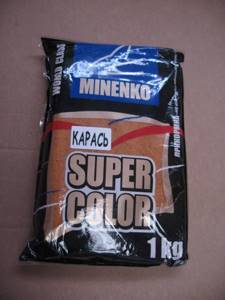
Minenko Super Color for crucian carp
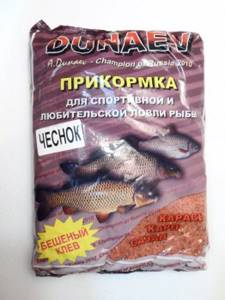
Dunaev is the undisputed authority in bait
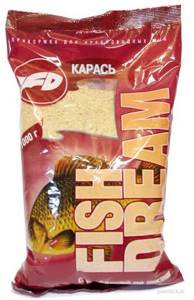
Fish Dream
Homemade
If you have enough time, you can prepare bait for crucian carp yourself, it’s not at all difficult. These recipes are developed based on the experience of fishermen. It must be remembered that the bait should not contain components unfamiliar to crucian carp; their smell does not attract, but on the contrary, scares.
Let's give an example of homemade bait that crucian carp loves so much. This recipe is based on the experience of fishermen and works flawlessly.
Ingredients:
- Crushed wheat and barley – one kilogram each.
- Corn grits - half a kilogram.
- Corn flour – 200 grams.
- Semolina – 200 grams.
- Sunflower cake – 200 grams.
- You will need Corvalol as a flavoring agent (20 drops will be enough).
Method of preparation: mix all the ingredients and soak for about twenty minutes (water is taken from the reservoir where fishing will take place), add flavoring. Then we form small balls from the finished mass.
Float fishing technique for crucian carp
The float rod allows you to fish at a depth of no more than three meters. Crucian carp mostly live closer to the bottom, so the float needs to be placed further away from the hook. This distance means the depth at which fishing is carried out.
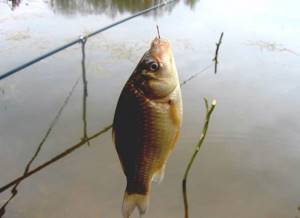
To properly set up the equipment, you should first set the approximate expected depth and look at the position of the float. If it stands vertically, then the distance must be increased until the float moves to a horizontal position. This means that the hook is on the bottom and the distance between the float and the hook needs to be reduced a little.
catch crucian carp at night only in absolutely abnormal heat, when the water temperature “subsides” only at night. Then the crucian carp begins to act. But it is worth remembering that this only works in extreme heat; otherwise, night fishing for crucian carp does not involve any kind of catch.
The best fishing hours are midday with bright sun and gusty wind, at which time the food of crucian carp rises from the depths. There are also fans of night fishing, since at this time of day it is quite quiet and the crucian carp becomes active.
Finding a fishing spot
Crucian carp is very unpretentious and is found in many reservoirs. It can even live in ditches and swamps. Fishing sites can be classified into three types:
- Small lakes and reservoirs that dry up from time to time. There is very little food in them and almost nothing except crucian carp feeds. Of course, it’s impossible to catch big fish, but it’s not difficult to get a decent catch of small crucian carp.
- Large artificial or forest reservoirs filled with various fish. Here you can hope to catch a large specimen, but this is not so easy due to the presence of predatory individuals.
- Small rivers or estuaries where large and active fish are found. There, crucian carp either hide in creeks or migrate up the river.
Fishing from the shore
To catch crucian carp from the shore, it will be enough to use a fly rod.
Features of fishing on the river:
- If there are places equipped for fishing on the coastline, then it is better to settle there.
- It is good to fish in creeks, river branches and other places full of vegetation near the banks.
Features of fishing in still water:
- The optimal fishing spot is among the reeds.
- The crucian carp should be fed.
To avoid spooking the fish, it is important to remain quiet.
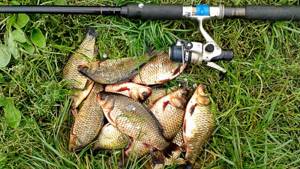
Fishing for crucian carp from a boat
Fishing from a boat involves deeper places, which means it would be better to use a mast fishing rod, about five meters long.
Features of fishing on the river:
- You can find fishing spots faster.
- Crucian carp lives in shallows far from the shore. It is usually full of algae vegetation.
- The bait should have a denser structure so that it does not get washed away by the current.
Features of fishing in still water:
- It is better to fish at shallow depths, up to one and a half meters.
- In still water it is easy to secure the boat in a fishing spot.
- Look for a place with changes in depth or vegetation.
Crucian carp and reeds
Like any aquatic plants, reeds are the most preferred places for crucian carp. There is plenty of food (flies, mosquitoes and other insects), a comfortable temperature, a good place for eggs and a lot of silt, which crucian carp like so much. It’s true that fishing here is not very convenient.
A number of difficulties arise:
- It is difficult to get to open water through the thickets;
- Additional equipment is needed (rubber suit and boat);
- Frequent cases of fishing line getting tangled in reeds.
A few tricky secrets for fishing in the reeds:
- You need to use a small fishing rod, with it there is less chance of losing the equipment in the grass. A fly rod with a rod size of approximately three meters is suitable.
- For the convenience of fishing, the reeds are cut to the water level, and directly in the area where the fishing rod is installed, they are simply bent.
- To understand whether there is crucian carp here, you should not immediately feed it, otherwise a bunch of all kinds of small fish will come running. First you just need to try to lure him out with a fishing rod and bait.
- When choosing a boat, it is better to give preference to rubber or wooden ones; they make less noise.
- The depth of fishing does not matter; crucian carp can be found everywhere.
Watch fishing for large crucian carp online
Fishing technique
T
The fishing technique in April is characterized by a constant search for fish. You literally need to sit on the tail of a crucian carp to provoke it to bite. Feed several points at once and fish them one by one. One ball of complementary food the size of a tangerine for each attractive area will be quite enough.
On warm May days, fish begin to accumulate in their usual habitats, feeding intensively before spawning. Choose a suitable place where, in your opinion, the crucian carp is located, and point feed the area where you will cast the fishing rod. To attract fish and keep them on the bait spot, you will need 2-3 balls of bait the size of an average orange. If fishing is carried out on a small pond with a dense concentration of fish, one ball will be enough.
When the bite weakens, from time to time throw up lumps of food the size of a cherry and try to tempt the crucian carp with sandwiches - all sorts of combinations of several baits and attachments. In April, a popular combination is bloodworms + maggots; in May, worms + maggots, a combination of worms with canned corn, and steamed barley grains with maggots have proven themselves to be excellent.
Video on catching crucian carp in spring
Watch catching crucian carp in May using maggots:
Fishing for crucian carp in April using a float rod with bite alarms (bells):
Features of fishing in April
Crucian carp begin to respond to fishing tricks no earlier than mid-April. It makes no sense to try to catch crucian carp in large and deep reservoirs in April. Look for small ponds, swampy spills, drainage ditches of peat bogs and other places where warming water encourages crucian carp to become active.
On April days, fish do not stay long in one area, even the most promising one. The crucian carp bites sluggishly and pokes its nose into the bait for a long time, not daring to take it. The reason is not at all the suspicion of the April crucian carp. The fish have not yet entered into intensive feeding mode, and constant movements are associated not so much with the search for food, but with the need to warm up in cold water.
In April, morning fishing is rarely productive because after a cold night the fish need time to replenish their energy. In April, sometimes the best fishing hours come in the afternoon, when the water warms up to its maximum level.
Features of fishing in May
In May, crucian carp revive almost everywhere, expanding the angler's geography in search of promising places. The fish's appetite flares up, and it becomes easier to tempt it to bite. In warm water, odors spread much better, which gives free rein to the angler’s imagination in preparing bait mixtures and experimenting with baits.
In May, crucian carp do not move around the reservoir much. Occupying their usual areas, crucian carp feed intensively. The fisherman does not need to run along the shore, looking for circles in the water. It is enough to occupy and feed the points that worked last summer.
In May, the crucian carp returns to its typical feeding schedule: morning and evening. This does not mean that you can reel in your gear by lunchtime. Try catching crucian carp in the midday heat. During the pre-spawning period, the fish are hungry, so the daytime bite, although weakened, does not stop. Spawning of crucian carp occurs in the third ten days of May - early June. At this time, switch to catching other fish.
Seasonality of crucian carp fishing
Crucian carp does not stay in one place; from time to time it makes migrations, both feeding and spawning. They directly depend on the change of seasons. If you understand its movements, it is not difficult to identify good fishing spots at different times of the year.
Spring
March .
In early spring, crucian carp wakes up and rises from the bottom. You can feed it, but not with plant food, after which the fish may stop biting altogether. Suitable baits include worms, maggots and bloodworms. April is considered the opening of the spring crucian fishing season. The water begins to warm up and you can find it in all sorts of creeks where there is a lot of vegetation left from last year. The end of April is considered the most productive time for fishing.
May. most active crucian carp can be found in small reservoirs, since full spring has arrived, and the water in them has already warmed up well. These are lakes and ponds with a depth of no more than a meter, full of reeds and reeds. At the end of May it can be difficult to find a crucian carp site, but early in the morning it can be found in the coastal grass. In addition to the worm, insects are also used as baits (dragonfly larvae, leeches, etc.)
Fishing for crucian carp in summer
June. In summer, the most optimal fishing hours are early in the morning or before sunset.
If the reservoir is crowded with other fish, then it is better to fish during the day. During the summer months, crucian carp are easy to find in the reed zone or among fallen trees. The fishing rod should be small and light. July. In July, a productive result can be obtained if you go out for crucian carp at five in the morning or at nine in the evening. Crucian carp can also be found in shallow open areas with a muddy bottom. In good weather it comes to the shore, and in bad weather it hides among the vegetation. If the sun is hot outside, the crucian carp moves to shaded areas. In addition to worms and maggots, you can use cereals and dough when fishing for crucian carp in summer, but you should be careful with bait and use it only for catching a large number of individuals.
August. This month begins the active movement of fish associated with night cold snaps. The crucian carp comes out of the grass zone onto its border and sinks to the bottom. Therefore, fishing by boat is more effective. Night fishing is also becoming popular; a particularly good catch is noted if it was warm and sunny during the day. Also, before going out into the pond, you should prepare good bait.
Fishing for crucian carp in autumn
September
. In autumn, every day it gets colder outside, and the crucian carp becomes more lethargic, and this is accordingly reflected in the behavior of the crucian carp.
The catch becomes significantly less than in the summer. Fishing must be done in deep waters with a current. The most active time is midday, and after lunch the bite subsides. October. In October, fishing directly depends on the weather. On warm days, it’s a good idea to fish in deep-sea lakes or ponds. Towards the middle of the month, the bait is changed from plant to animal, as the crucian carp stops responding to the first one. The bait is applied in small doses three meters from the shore, which is where the crucian carp lives. Therefore, when fishing from the shore, the fishing rod should be long, up to seven meters.
November. In November, you should go fishing for crucian carp before ten in the morning, or an hour before sunset; the rest of the time, fishing is ineffective. You should look for crucian carp only on clear days at a depth of up to five meters. In November, crucian carp have to be fished almost from the bottom, so the bait is dropped as deep as possible.
Since crucian carp is a very common and affordable fish, fishing for it will always be relevant. Using a float rod is a pleasure for both beginners and experienced fishermen. If you know all the behavioral features of this fish and all the subtleties of catching it, you can achieve good results at any time of the year.
The best weather conditions and time (months, hours) for good crucian carp fishing
- Crucian carp, like most fish, is preferably caught in the early morning and evening.
- Note that the best bite for crucian carp is in the spring, especially at the end of April or beginning of May. This is explained by the fact that the water begins to warm up, and the crucian carp is looking for food.
- Wind. The wind has a special influence on the choice of location. It is better when the South-West wind blows at your back, which brings warmth. By the way, in windy weather the bite of crucian carp will be more active.
- Temperature. Temperature will also have a strong influence on the bite. Usually crucian carp begins to bite when the water temperature is more than 10 degrees Celsius. Temperatures between 20 and 26 degrees Celsius are best. In these conditions, crucian carp is especially active.
- Note that when the temperature drops, crucian carp prefer to gather in shallow water.
- Atmosphere pressure. As atmospheric pressure changes, the oxygen level in the reservoir also changes. When it increases, the oxygen level decreases; when it decreases, it increases. Crucian carp bite more actively at low pressure. This usually occurs in rainy or windy weather. For reference: pressure is more than 750 mm Hg. Art. considered high.
- The nuances of fishing for crucian carp at night. Catching crucian carp at night requires additional knowledge. If you notice noise in the reeds, then this is a sure sign that large fish are feeding in shallow water. Therefore, you need to be very careful when catching crucian carp at night using a float rod. Such places usually have a depth of no more than 30 cm. It is best to use a light float, which does not create more noise when thrown into the water. Prepare a specially glowing float. This will help you make the fishing process much easier. You also need to point out that when fishing from a boat, you need to swim from the clean bottom and not too close to the shore. Being as careful and quiet as possible will help you avoid spooking all the fish.
